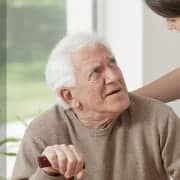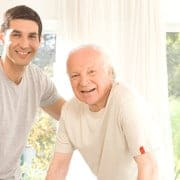May is American Stroke Month
In our last blog, we discussed osteoporosis, as May is National Osteoporosis Prevention & Awareness Month. May is also American Stroke Month!
Because the risk of stroke doubles each decade after age 55 (American Heart Association), prevention and early care are crucial in a positive, long-term prognosis for our elderly residents. Assisted Living Education is here to cover some key information about strokes, including how to recognize if someone is having a stroke, the different types of strokes, and basic prevention measures to implement in an assisted living facility.
Basic Facts
According to the American Stroke Association, someone in the United States experiences a stroke every 40 seconds, and it is the number one cause of long-term disability in this country. The American Heart Association states that every four minutes, a death is caused by a stroke. However, the AHA also states that stroke is one of the more preventable conditions, by as much as one third. Additionally, immediate care is the key to reducing brain damage caused by stroke, as 2 million brain cells die each minute a stroke goes untreated (American Stroke Association).
Recognizing A Stroke: F.A.S.T!
Timely treatment for a stroke is essential in preventing long-term, debilitating brain damage for the resident.
F.A.S.T. is an easy and useful acronym to help identify if someone is experiencing a stroke.
F: Is one side of the face drooping or is their smile uneven? Ask the person to smile if you are unsure.
A: Are they experiencing numbness or weakness in one arm? Ask the person to lift both arms to see if one drifts down, or if they are otherwise unable to control it.
S: Is their speech slurred or are they having difficulty talking and hard to understand? Ask them to repeat a simple sentence, e.g., “I like chocolate.”
T: Time to call 9-1-1. Even if the symptoms seem to go away, immediately
call 9-1-1 or emergency medical services and note the time that you
first recognized these symptoms.
Other Symptoms
The following symptoms may also be apparent in someone experiencing a stroke, and their sudden onset is a key signal that something is wrong.
- Numbness or weakness: This can be experienced in the face, arm, or leg, especially on one side of the body.
- Confusion: The resident may seem suddenly confused, and have difficulty with their speech or understanding speech (dysphasia).
- Difficulty Walking: Sudden dizziness and trouble with walking, balance or coordination can occur.
- Impaired Vision: The resident may have difficulty seeing out of one or both eyes.
- Severe Headache: A sudden headache may come on with no apparent cause or trigger.
Knowing your residents and interacting with them frequently can help you recognize behaviors that are unusual for the individual. Some residents may already have difficulties with speech or cognition, weakness and/or limited mobility due to other conditions, so it is important to determine and know individual baselines to distinguish symptoms that are out of their norm.
Types of Strokes
There are two main types of strokes, Ischemic and Hemorrhagic, and a less severe event called a Transient Ischemic Attack (TIA). However, each one should be considered seriously for the long-term well-being of the resident.
Ischemic – Clots
The AHA states that 87% of all strokes are ischemic and caused by an obstruction in an artery that supplies blood to the brain. Ischemic strokes are further divided into two categories: thrombotic and embolic.
Thrombotic strokes occur when there’s a clot or obstruction within the brain, also known as cerebral thrombosis or cerebral infarction. These account for about 50% of all strokes. There are two kinds of thrombotic strokes, large-vessel thrombosis and small-vessel thrombosis. Large-vessel thrombosis refers to a blockage in one of the major arteries supplying blood to the brain, such as the carotid or middle cerebral. Small-vessel thrombosis occurs in one or more of the smaller arteries carrying blood to the brain.
Embolic stroke is a clot that occurs in an artery in the body besides the brain. Frequently, they come from the heart and travel through the bloodstream, until they get stuck and can no longer pass, restricting blood flow to the brain.
Hemorrhagic – Blood leaking in/around the brain
A hemorrhagic stroke describes when blood is leaking in or around the brain. The National Stroke Association reports that only about 15% of strokes are hemorrhagic, but they account for 40% of stroke deaths. There are two types of hemorrhagic strokes, intracerebral and subarachnoid.
Intracerebral hemorrhage is the more common of the two, and occurs when a weakened blood vessel ruptures and leaks blood into the brain. As blood collects, it causes an increase in pressure to the surrounding brain tissue. Because of this, brain cells can die and cause the affected area to stop functioning properly.
Subarachnoid hemorrage is when there is bleeding between the brain and the tissue surrounding the brain. This is most commonly caused by a burst aneurysm, but can also happen due to a genetic condition, head injury, bleeding disorders, or blood thinners.
Transient Ischemic Attacks (TIAs)
A Transient Ischemic Attack is when blood flow to the brain is stopped temporarily, and symptoms appear only for a short time, the average around one to five minutes. The temporary obstruction can be a blood clot, or a cholesterol plaque, which can break off and cause arterial blockage.
Sometimes called a ‘mini-stroke,’ TIAs are more appropriately called a ‘warning stroke’ because a more serious one is likely to occur in the near future. Not everyone has a TIA before a stroke, but the AHA indicates that about one-third of those who experience one go on to have a stroke within just a year.
TIAs manifest the same or similar symptoms to a stroke, but they do not cause permanent brain damage or disability. However, it is critical to call emergency services immediately with any signs or symptoms, because at the initial onset, it may be difficult to distinguish between a TIA or a major stroke.
Stroke Prevention in Assisted Living
Though some factors are beyond our control, there are still preventative efforts assisted living facilities can enforce. Of course, each of the following must be approved through the appropriate channels before implementing any changes to a resident’s individual care plan.
Nutrition
Ensuring proper nutrition among residents and healthy eating habits can help fight obesity, reduce bad cholesterol and high blood pressure, all of which can contribute to increased risk of stroke. The in-house dietitian can design appropriate nutrition programs and supplements for residents who present a greater risk of stroke incidence. Common dietary adjustments include limiting sodium intake; supplementing B6, B12 & folic acid; increasing consumption of fruits, vegetables, & high fiber foods; and consuming foods low in saturated fats, trans fats, and cholesterol.
Medications
Anticoagulants such as warfarin, or antiplatelet medications like Aspirin or Bayer are often prescribed for regular use to prevent blood clots and reduce the risk of stroke.
For residents with high blood pressure, they may require antihypertensives, which can act in a few different ways, depending on the medication. Some work by dilating the blood vessels, others decrease blood volume, while certain types reduce the rate or force of the heart’s contractions.
Exercise
Encouraging exercise and movement in elderly residents can also help in stroke prevention. Exercise can naturally reduce blood pressure and increase the ‘good’ cholesterol (HDL). Mood and sleep patterns also improve with exercise, which can help enhance overall body function. Exercise and movement are also good for blood flow, and keeping the blood vessels and heart strong.
At Assisted Living Education, our ultimate goal is to promote the well-being, safety, and happiness of our elderly population. We do this by providing premier education, licensing, products and services for assisted living. Our teachers are long-time industry professionals ready to share their knowledge in a highly engaging, entertaining, yet informative context. Find out how to receive your RCFE Certification, sign up for continuing education courses, or staff training classes. Visit our contact page for our location and how to contact us. We look forward to hearing from you!




